University Assignment: Calculations for 2.5 Ton Air Conditioner Design
VerifiedAdded on 2019/10/30
|17
|3097
|182
Report
AI Summary
This report details the calculations used to design a 2.5-ton air conditioner, covering essential aspects like heat measurement in BTUs, sizing considerations, and energy costs. The report explains how to determine cooling needs and discusses the importance of a "Manual J" calculation for accurate system sizing. It explores the technical definition of a BTU, calculations for heating air, and the cost of removing heat generated by appliances. The report also includes practical tips on using AC timers, smart thermostats, and the benefits of geothermal systems. Furthermore, the report describes the initial design phase, specifically the creation of a box for the heat exchanger/evaporator using Creo 2.0, including the dimensions and steps involved. The report also touches on the design of the box and its role in supporting other components. Finally, it includes references for further study.
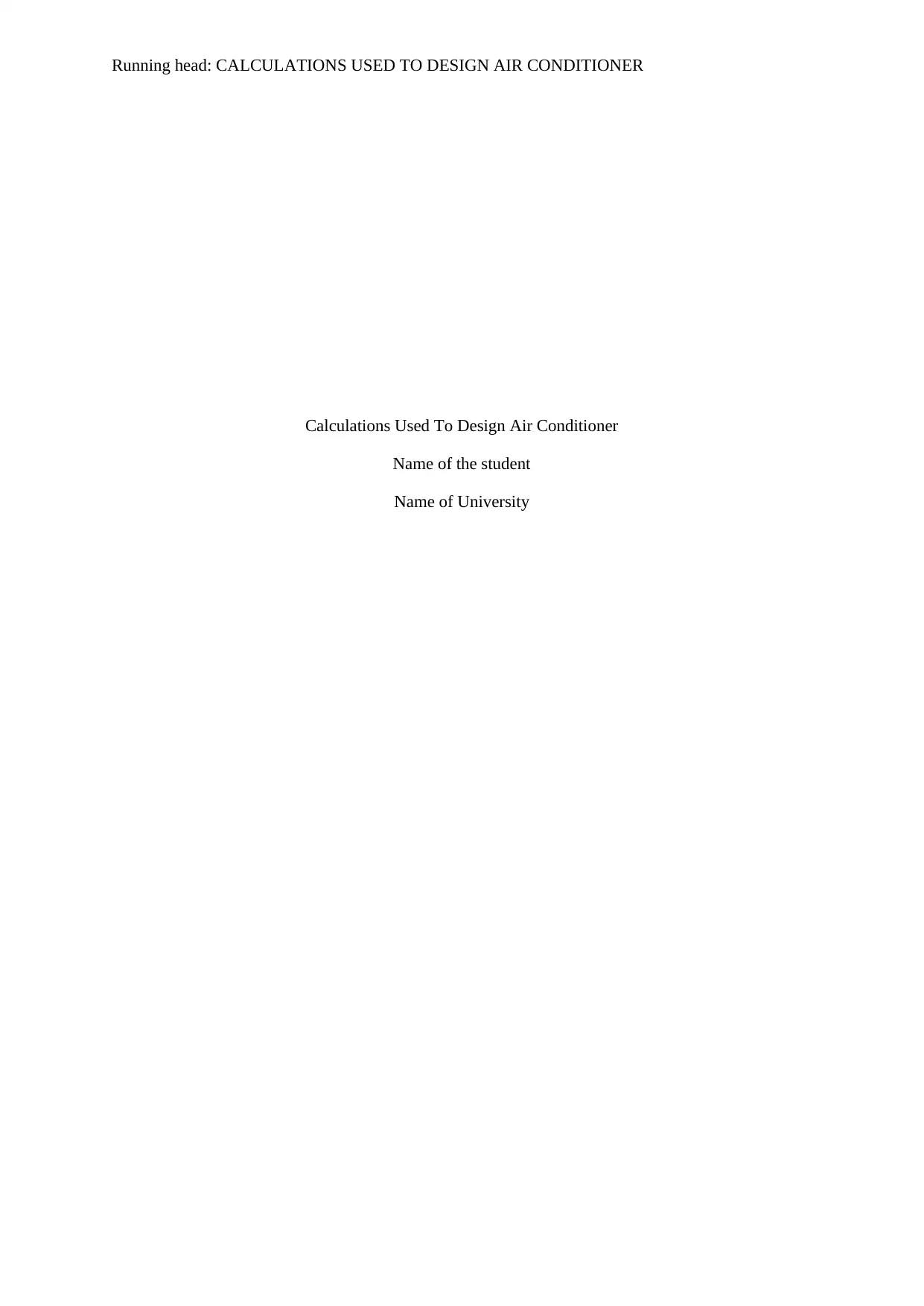
Running head: CALCULATIONS USED TO DESIGN AIR CONDITIONER
Calculations Used To Design Air Conditioner
Name of the student
Name of University
Calculations Used To Design Air Conditioner
Name of the student
Name of University
Paraphrase This Document
Need a fresh take? Get an instant paraphrase of this document with our AI Paraphraser

CALCULATIONS USED TO DESIGN AIR CONDITIONER 1
Table of Contents
Calculations used to design a 2.5 ton air conditioner..............................................................................2
The measurement of heat........................................................................................................2
BTUs: Technical definition...............................................................................................3
BTUs to heat air..................................................................................................................3
Cost to remove heat generated by appliance use....................................................................4
Use an AC timer or smart thermostat:....................................................................................5
Geothermal systems:...............................................................................................................6
Design:....................................................................................................................................7
Part 1- Box -.......................................................................................................................7
References:.............................................................................................................................................15
Table of Contents
Calculations used to design a 2.5 ton air conditioner..............................................................................2
The measurement of heat........................................................................................................2
BTUs: Technical definition...............................................................................................3
BTUs to heat air..................................................................................................................3
Cost to remove heat generated by appliance use....................................................................4
Use an AC timer or smart thermostat:....................................................................................5
Geothermal systems:...............................................................................................................6
Design:....................................................................................................................................7
Part 1- Box -.......................................................................................................................7
References:.............................................................................................................................................15
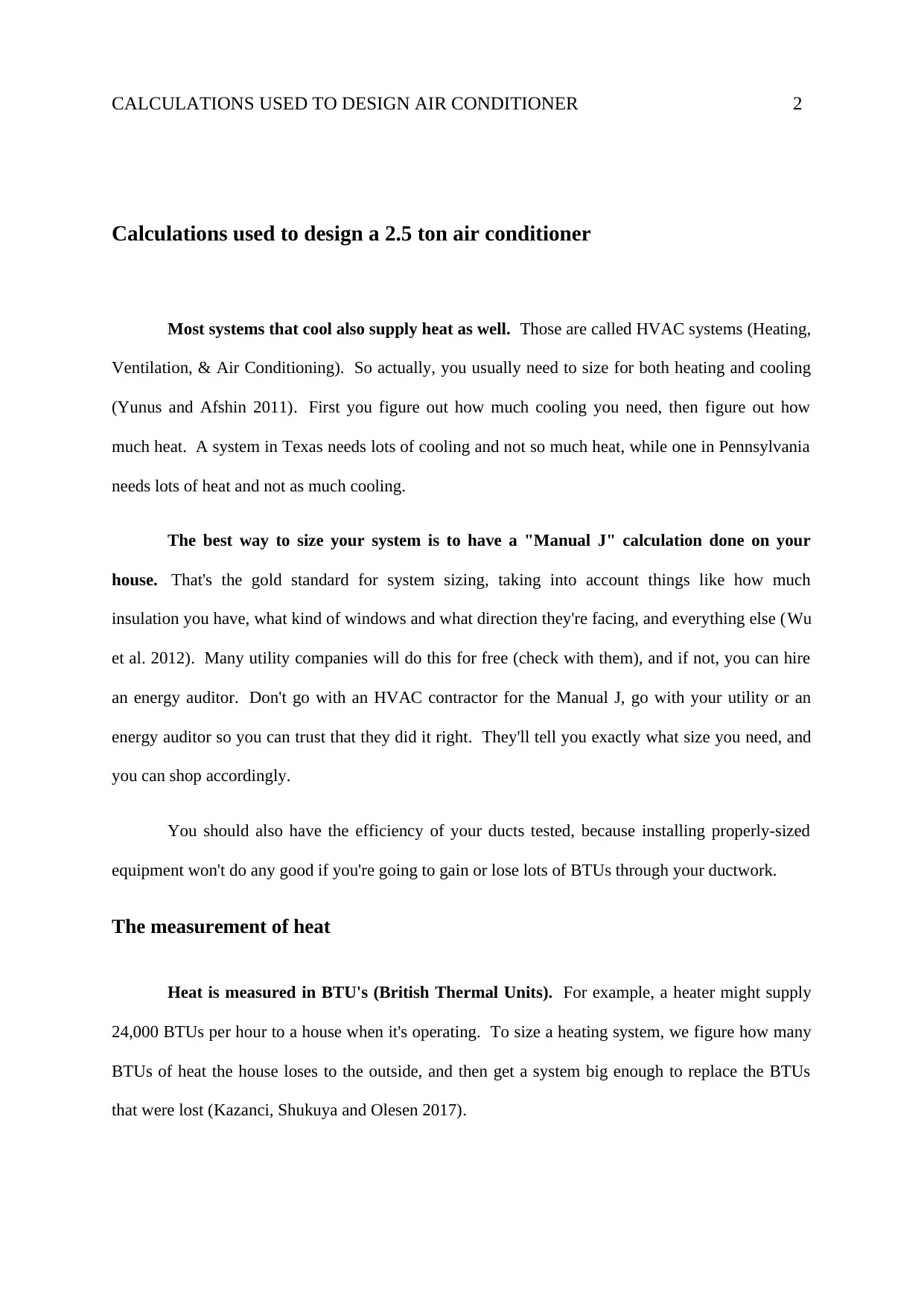
CALCULATIONS USED TO DESIGN AIR CONDITIONER 2
Calculations used to design a 2.5 ton air conditioner
Most systems that cool also supply heat as well. Those are called HVAC systems (Heating,
Ventilation, & Air Conditioning). So actually, you usually need to size for both heating and cooling
(Yunus and Afshin 2011). First you figure out how much cooling you need, then figure out how
much heat. A system in Texas needs lots of cooling and not so much heat, while one in Pennsylvania
needs lots of heat and not as much cooling.
The best way to size your system is to have a "Manual J" calculation done on your
house. That's the gold standard for system sizing, taking into account things like how much
insulation you have, what kind of windows and what direction they're facing, and everything else (Wu
et al. 2012). Many utility companies will do this for free (check with them), and if not, you can hire
an energy auditor. Don't go with an HVAC contractor for the Manual J, go with your utility or an
energy auditor so you can trust that they did it right. They'll tell you exactly what size you need, and
you can shop accordingly.
You should also have the efficiency of your ducts tested, because installing properly-sized
equipment won't do any good if you're going to gain or lose lots of BTUs through your ductwork.
The measurement of heat
Heat is measured in BTU's (British Thermal Units). For example, a heater might supply
24,000 BTUs per hour to a house when it's operating. To size a heating system, we figure how many
BTUs of heat the house loses to the outside, and then get a system big enough to replace the BTUs
that were lost (Kazanci, Shukuya and Olesen 2017).
Calculations used to design a 2.5 ton air conditioner
Most systems that cool also supply heat as well. Those are called HVAC systems (Heating,
Ventilation, & Air Conditioning). So actually, you usually need to size for both heating and cooling
(Yunus and Afshin 2011). First you figure out how much cooling you need, then figure out how
much heat. A system in Texas needs lots of cooling and not so much heat, while one in Pennsylvania
needs lots of heat and not as much cooling.
The best way to size your system is to have a "Manual J" calculation done on your
house. That's the gold standard for system sizing, taking into account things like how much
insulation you have, what kind of windows and what direction they're facing, and everything else (Wu
et al. 2012). Many utility companies will do this for free (check with them), and if not, you can hire
an energy auditor. Don't go with an HVAC contractor for the Manual J, go with your utility or an
energy auditor so you can trust that they did it right. They'll tell you exactly what size you need, and
you can shop accordingly.
You should also have the efficiency of your ducts tested, because installing properly-sized
equipment won't do any good if you're going to gain or lose lots of BTUs through your ductwork.
The measurement of heat
Heat is measured in BTU's (British Thermal Units). For example, a heater might supply
24,000 BTUs per hour to a house when it's operating. To size a heating system, we figure how many
BTUs of heat the house loses to the outside, and then get a system big enough to replace the BTUs
that were lost (Kazanci, Shukuya and Olesen 2017).
⊘ This is a preview!⊘
Do you want full access?
Subscribe today to unlock all pages.

Trusted by 1+ million students worldwide
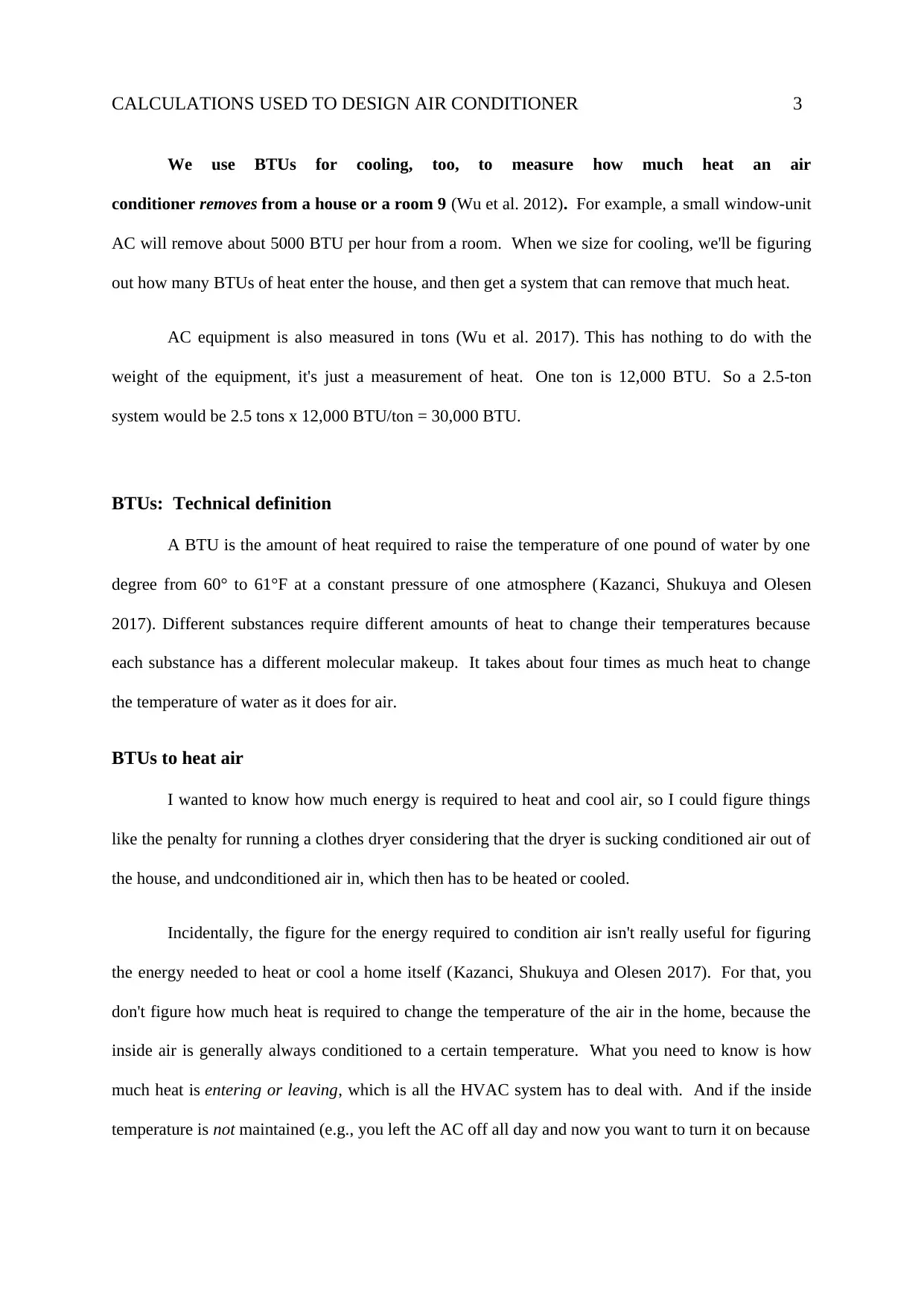
CALCULATIONS USED TO DESIGN AIR CONDITIONER 3
We use BTUs for cooling, too, to measure how much heat an air
conditioner removes from a house or a room 9 (Wu et al. 2012). For example, a small window-unit
AC will remove about 5000 BTU per hour from a room. When we size for cooling, we'll be figuring
out how many BTUs of heat enter the house, and then get a system that can remove that much heat.
AC equipment is also measured in tons (Wu et al. 2017). This has nothing to do with the
weight of the equipment, it's just a measurement of heat. One ton is 12,000 BTU. So a 2.5-ton
system would be 2.5 tons x 12,000 BTU/ton = 30,000 BTU.
BTUs: Technical definition
A BTU is the amount of heat required to raise the temperature of one pound of water by one
degree from 60° to 61°F at a constant pressure of one atmosphere (Kazanci, Shukuya and Olesen
2017). Different substances require different amounts of heat to change their temperatures because
each substance has a different molecular makeup. It takes about four times as much heat to change
the temperature of water as it does for air.
BTUs to heat air
I wanted to know how much energy is required to heat and cool air, so I could figure things
like the penalty for running a clothes dryer considering that the dryer is sucking conditioned air out of
the house, and undconditioned air in, which then has to be heated or cooled.
Incidentally, the figure for the energy required to condition air isn't really useful for figuring
the energy needed to heat or cool a home itself (Kazanci, Shukuya and Olesen 2017). For that, you
don't figure how much heat is required to change the temperature of the air in the home, because the
inside air is generally always conditioned to a certain temperature. What you need to know is how
much heat is entering or leaving, which is all the HVAC system has to deal with. And if the inside
temperature is not maintained (e.g., you left the AC off all day and now you want to turn it on because
We use BTUs for cooling, too, to measure how much heat an air
conditioner removes from a house or a room 9 (Wu et al. 2012). For example, a small window-unit
AC will remove about 5000 BTU per hour from a room. When we size for cooling, we'll be figuring
out how many BTUs of heat enter the house, and then get a system that can remove that much heat.
AC equipment is also measured in tons (Wu et al. 2017). This has nothing to do with the
weight of the equipment, it's just a measurement of heat. One ton is 12,000 BTU. So a 2.5-ton
system would be 2.5 tons x 12,000 BTU/ton = 30,000 BTU.
BTUs: Technical definition
A BTU is the amount of heat required to raise the temperature of one pound of water by one
degree from 60° to 61°F at a constant pressure of one atmosphere (Kazanci, Shukuya and Olesen
2017). Different substances require different amounts of heat to change their temperatures because
each substance has a different molecular makeup. It takes about four times as much heat to change
the temperature of water as it does for air.
BTUs to heat air
I wanted to know how much energy is required to heat and cool air, so I could figure things
like the penalty for running a clothes dryer considering that the dryer is sucking conditioned air out of
the house, and undconditioned air in, which then has to be heated or cooled.
Incidentally, the figure for the energy required to condition air isn't really useful for figuring
the energy needed to heat or cool a home itself (Kazanci, Shukuya and Olesen 2017). For that, you
don't figure how much heat is required to change the temperature of the air in the home, because the
inside air is generally always conditioned to a certain temperature. What you need to know is how
much heat is entering or leaving, which is all the HVAC system has to deal with. And if the inside
temperature is not maintained (e.g., you left the AC off all day and now you want to turn it on because
Paraphrase This Document
Need a fresh take? Get an instant paraphrase of this document with our AI Paraphraser
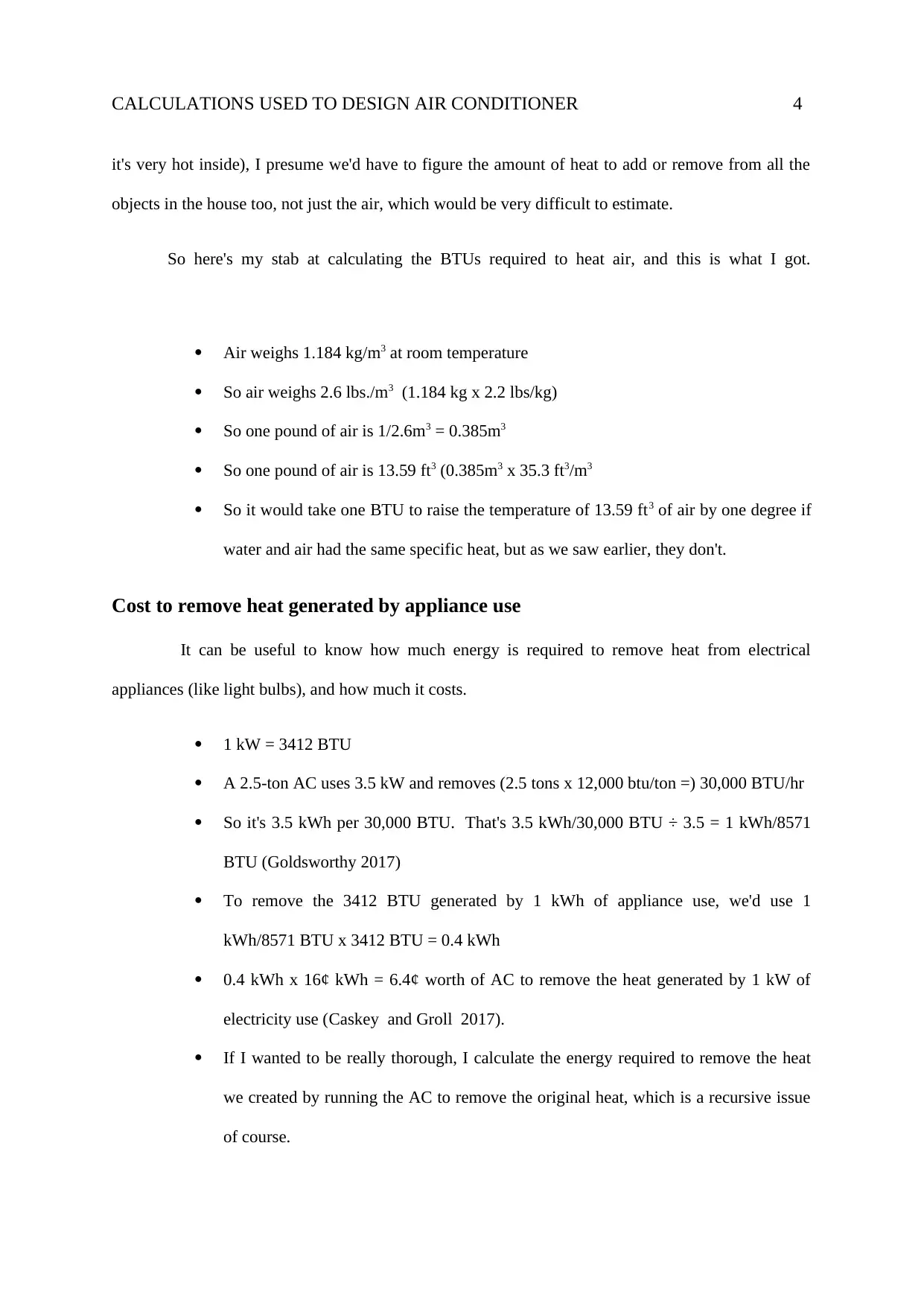
CALCULATIONS USED TO DESIGN AIR CONDITIONER 4
it's very hot inside), I presume we'd have to figure the amount of heat to add or remove from all the
objects in the house too, not just the air, which would be very difficult to estimate.
So here's my stab at calculating the BTUs required to heat air, and this is what I got.
Air weighs 1.184 kg/m3 at room temperature
So air weighs 2.6 lbs./m3 (1.184 kg x 2.2 lbs/kg)
So one pound of air is 1/2.6m3 = 0.385m3
So one pound of air is 13.59 ft3 (0.385m3 x 35.3 ft3/m3
So it would take one BTU to raise the temperature of 13.59 ft3 of air by one degree if
water and air had the same specific heat, but as we saw earlier, they don't.
Cost to remove heat generated by appliance use
It can be useful to know how much energy is required to remove heat from electrical
appliances (like light bulbs), and how much it costs.
1 kW = 3412 BTU
A 2.5-ton AC uses 3.5 kW and removes (2.5 tons x 12,000 btu/ton =) 30,000 BTU/hr
So it's 3.5 kWh per 30,000 BTU. That's 3.5 kWh/30,000 BTU ÷ 3.5 = 1 kWh/8571
BTU (Goldsworthy 2017)
To remove the 3412 BTU generated by 1 kWh of appliance use, we'd use 1
kWh/8571 BTU x 3412 BTU = 0.4 kWh
0.4 kWh x 16¢ kWh = 6.4¢ worth of AC to remove the heat generated by 1 kW of
electricity use (Caskey and Groll 2017).
If I wanted to be really thorough, I calculate the energy required to remove the heat
we created by running the AC to remove the original heat, which is a recursive issue
of course.
it's very hot inside), I presume we'd have to figure the amount of heat to add or remove from all the
objects in the house too, not just the air, which would be very difficult to estimate.
So here's my stab at calculating the BTUs required to heat air, and this is what I got.
Air weighs 1.184 kg/m3 at room temperature
So air weighs 2.6 lbs./m3 (1.184 kg x 2.2 lbs/kg)
So one pound of air is 1/2.6m3 = 0.385m3
So one pound of air is 13.59 ft3 (0.385m3 x 35.3 ft3/m3
So it would take one BTU to raise the temperature of 13.59 ft3 of air by one degree if
water and air had the same specific heat, but as we saw earlier, they don't.
Cost to remove heat generated by appliance use
It can be useful to know how much energy is required to remove heat from electrical
appliances (like light bulbs), and how much it costs.
1 kW = 3412 BTU
A 2.5-ton AC uses 3.5 kW and removes (2.5 tons x 12,000 btu/ton =) 30,000 BTU/hr
So it's 3.5 kWh per 30,000 BTU. That's 3.5 kWh/30,000 BTU ÷ 3.5 = 1 kWh/8571
BTU (Goldsworthy 2017)
To remove the 3412 BTU generated by 1 kWh of appliance use, we'd use 1
kWh/8571 BTU x 3412 BTU = 0.4 kWh
0.4 kWh x 16¢ kWh = 6.4¢ worth of AC to remove the heat generated by 1 kW of
electricity use (Caskey and Groll 2017).
If I wanted to be really thorough, I calculate the energy required to remove the heat
we created by running the AC to remove the original heat, which is a recursive issue
of course.
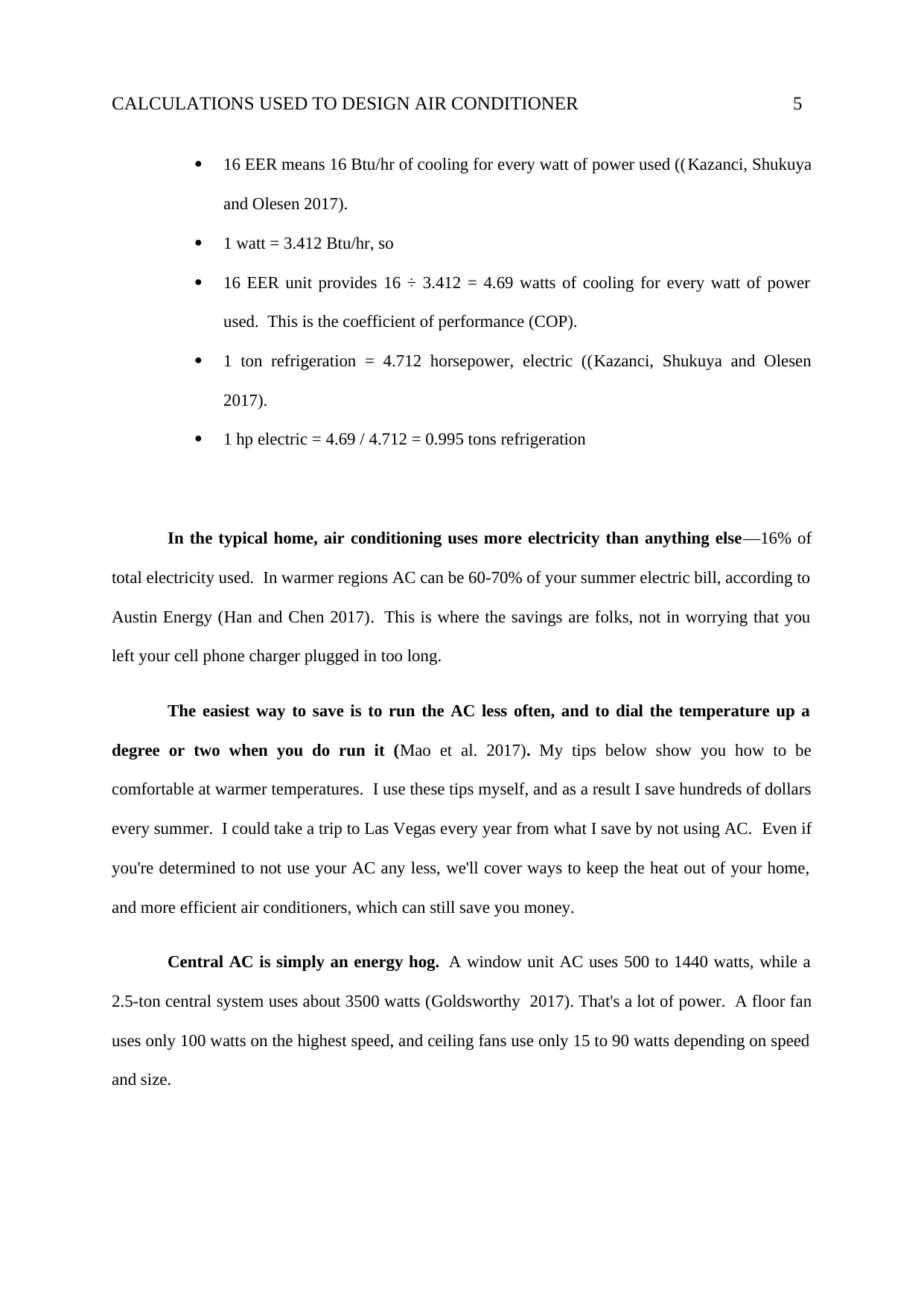
CALCULATIONS USED TO DESIGN AIR CONDITIONER 5
16 EER means 16 Btu/hr of cooling for every watt of power used ((Kazanci, Shukuya
and Olesen 2017).
1 watt = 3.412 Btu/hr, so
16 EER unit provides 16 ÷ 3.412 = 4.69 watts of cooling for every watt of power
used. This is the coefficient of performance (COP).
1 ton refrigeration = 4.712 horsepower, electric ((Kazanci, Shukuya and Olesen
2017).
1 hp electric = 4.69 / 4.712 = 0.995 tons refrigeration
In the typical home, air conditioning uses more electricity than anything else—16% of
total electricity used. In warmer regions AC can be 60-70% of your summer electric bill, according to
Austin Energy (Han and Chen 2017). This is where the savings are folks, not in worrying that you
left your cell phone charger plugged in too long.
The easiest way to save is to run the AC less often, and to dial the temperature up a
degree or two when you do run it (Mao et al. 2017). My tips below show you how to be
comfortable at warmer temperatures. I use these tips myself, and as a result I save hundreds of dollars
every summer. I could take a trip to Las Vegas every year from what I save by not using AC. Even if
you're determined to not use your AC any less, we'll cover ways to keep the heat out of your home,
and more efficient air conditioners, which can still save you money.
Central AC is simply an energy hog. A window unit AC uses 500 to 1440 watts, while a
2.5-ton central system uses about 3500 watts (Goldsworthy 2017). That's a lot of power. A floor fan
uses only 100 watts on the highest speed, and ceiling fans use only 15 to 90 watts depending on speed
and size.
16 EER means 16 Btu/hr of cooling for every watt of power used ((Kazanci, Shukuya
and Olesen 2017).
1 watt = 3.412 Btu/hr, so
16 EER unit provides 16 ÷ 3.412 = 4.69 watts of cooling for every watt of power
used. This is the coefficient of performance (COP).
1 ton refrigeration = 4.712 horsepower, electric ((Kazanci, Shukuya and Olesen
2017).
1 hp electric = 4.69 / 4.712 = 0.995 tons refrigeration
In the typical home, air conditioning uses more electricity than anything else—16% of
total electricity used. In warmer regions AC can be 60-70% of your summer electric bill, according to
Austin Energy (Han and Chen 2017). This is where the savings are folks, not in worrying that you
left your cell phone charger plugged in too long.
The easiest way to save is to run the AC less often, and to dial the temperature up a
degree or two when you do run it (Mao et al. 2017). My tips below show you how to be
comfortable at warmer temperatures. I use these tips myself, and as a result I save hundreds of dollars
every summer. I could take a trip to Las Vegas every year from what I save by not using AC. Even if
you're determined to not use your AC any less, we'll cover ways to keep the heat out of your home,
and more efficient air conditioners, which can still save you money.
Central AC is simply an energy hog. A window unit AC uses 500 to 1440 watts, while a
2.5-ton central system uses about 3500 watts (Goldsworthy 2017). That's a lot of power. A floor fan
uses only 100 watts on the highest speed, and ceiling fans use only 15 to 90 watts depending on speed
and size.
⊘ This is a preview!⊘
Do you want full access?
Subscribe today to unlock all pages.

Trusted by 1+ million students worldwide
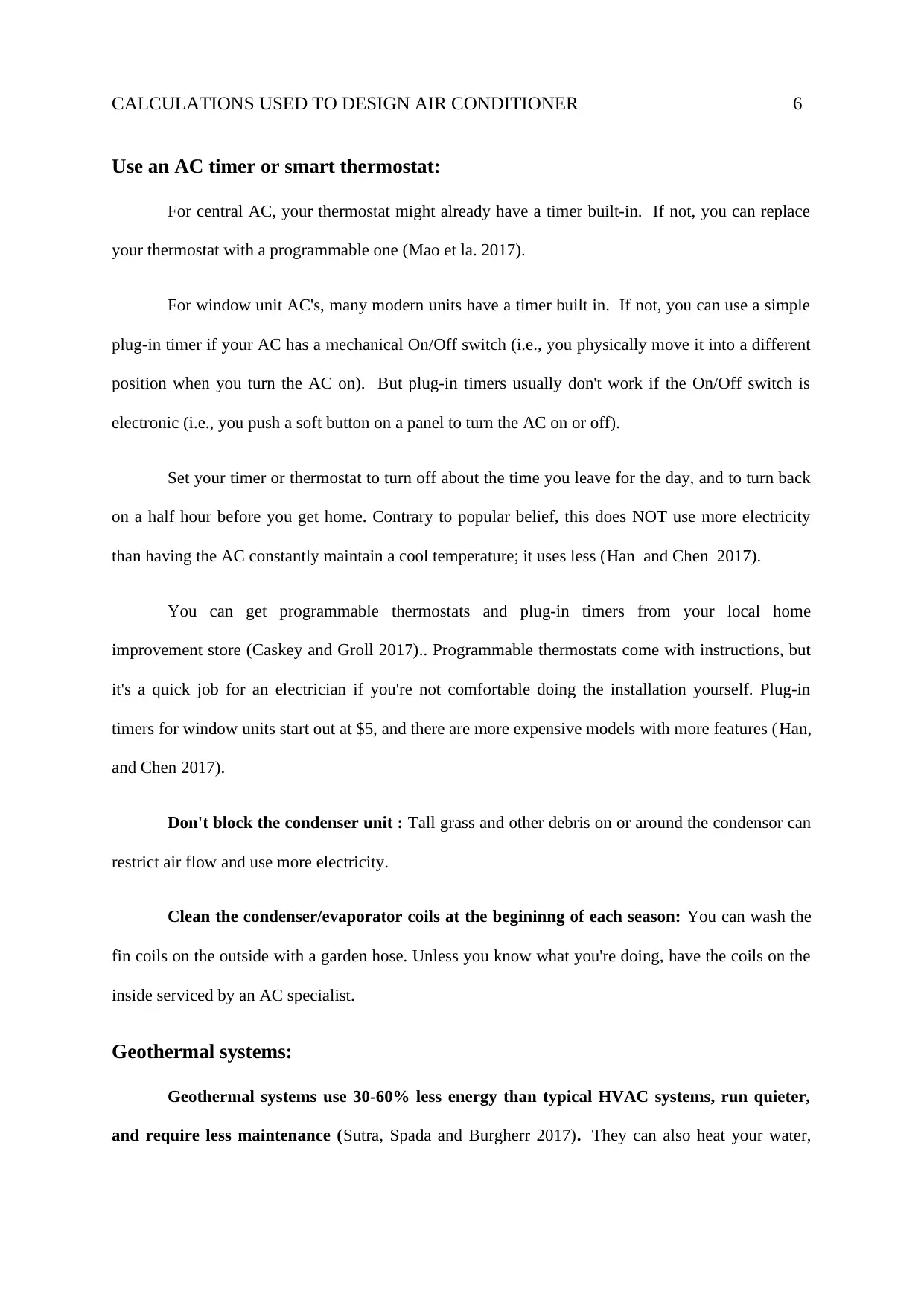
CALCULATIONS USED TO DESIGN AIR CONDITIONER 6
Use an AC timer or smart thermostat:
For central AC, your thermostat might already have a timer built-in. If not, you can replace
your thermostat with a programmable one (Mao et la. 2017).
For window unit AC's, many modern units have a timer built in. If not, you can use a simple
plug-in timer if your AC has a mechanical On/Off switch (i.e., you physically move it into a different
position when you turn the AC on). But plug-in timers usually don't work if the On/Off switch is
electronic (i.e., you push a soft button on a panel to turn the AC on or off).
Set your timer or thermostat to turn off about the time you leave for the day, and to turn back
on a half hour before you get home. Contrary to popular belief, this does NOT use more electricity
than having the AC constantly maintain a cool temperature; it uses less (Han and Chen 2017).
You can get programmable thermostats and plug-in timers from your local home
improvement store (Caskey and Groll 2017).. Programmable thermostats come with instructions, but
it's a quick job for an electrician if you're not comfortable doing the installation yourself. Plug-in
timers for window units start out at $5, and there are more expensive models with more features (Han,
and Chen 2017).
Don't block the condenser unit : Tall grass and other debris on or around the condensor can
restrict air flow and use more electricity.
Clean the condenser/evaporator coils at the begininng of each season: You can wash the
fin coils on the outside with a garden hose. Unless you know what you're doing, have the coils on the
inside serviced by an AC specialist.
Geothermal systems:
Geothermal systems use 30-60% less energy than typical HVAC systems, run quieter,
and require less maintenance (Sutra, Spada and Burgherr 2017). They can also heat your water,
Use an AC timer or smart thermostat:
For central AC, your thermostat might already have a timer built-in. If not, you can replace
your thermostat with a programmable one (Mao et la. 2017).
For window unit AC's, many modern units have a timer built in. If not, you can use a simple
plug-in timer if your AC has a mechanical On/Off switch (i.e., you physically move it into a different
position when you turn the AC on). But plug-in timers usually don't work if the On/Off switch is
electronic (i.e., you push a soft button on a panel to turn the AC on or off).
Set your timer or thermostat to turn off about the time you leave for the day, and to turn back
on a half hour before you get home. Contrary to popular belief, this does NOT use more electricity
than having the AC constantly maintain a cool temperature; it uses less (Han and Chen 2017).
You can get programmable thermostats and plug-in timers from your local home
improvement store (Caskey and Groll 2017).. Programmable thermostats come with instructions, but
it's a quick job for an electrician if you're not comfortable doing the installation yourself. Plug-in
timers for window units start out at $5, and there are more expensive models with more features (Han,
and Chen 2017).
Don't block the condenser unit : Tall grass and other debris on or around the condensor can
restrict air flow and use more electricity.
Clean the condenser/evaporator coils at the begininng of each season: You can wash the
fin coils on the outside with a garden hose. Unless you know what you're doing, have the coils on the
inside serviced by an AC specialist.
Geothermal systems:
Geothermal systems use 30-60% less energy than typical HVAC systems, run quieter,
and require less maintenance (Sutra, Spada and Burgherr 2017). They can also heat your water,
Paraphrase This Document
Need a fresh take? Get an instant paraphrase of this document with our AI Paraphraser
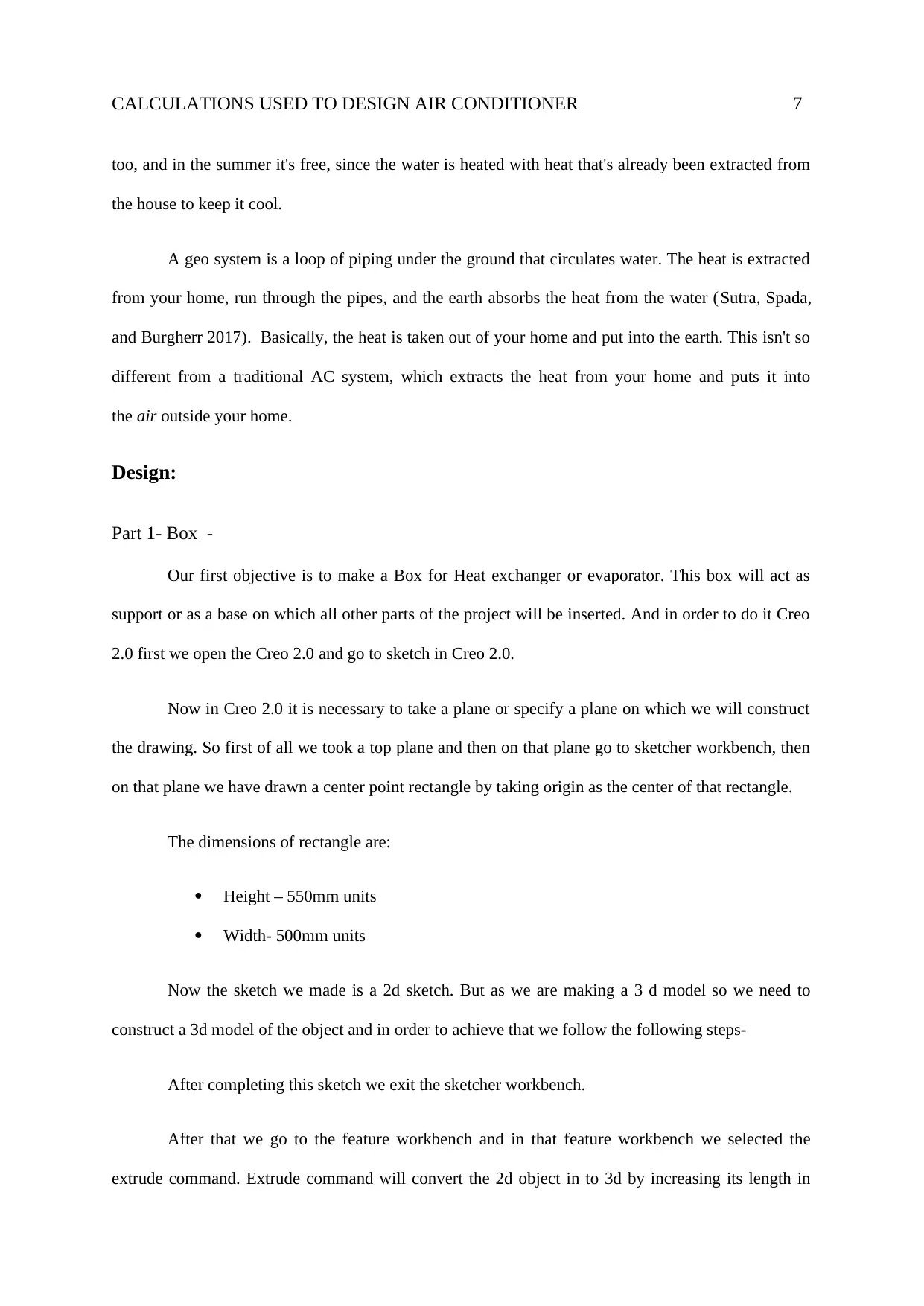
CALCULATIONS USED TO DESIGN AIR CONDITIONER 7
too, and in the summer it's free, since the water is heated with heat that's already been extracted from
the house to keep it cool.
A geo system is a loop of piping under the ground that circulates water. The heat is extracted
from your home, run through the pipes, and the earth absorbs the heat from the water (Sutra, Spada,
and Burgherr 2017). Basically, the heat is taken out of your home and put into the earth. This isn't so
different from a traditional AC system, which extracts the heat from your home and puts it into
the air outside your home.
Design:
Part 1- Box -
Our first objective is to make a Box for Heat exchanger or evaporator. This box will act as
support or as a base on which all other parts of the project will be inserted. And in order to do it Creo
2.0 first we open the Creo 2.0 and go to sketch in Creo 2.0.
Now in Creo 2.0 it is necessary to take a plane or specify a plane on which we will construct
the drawing. So first of all we took a top plane and then on that plane go to sketcher workbench, then
on that plane we have drawn a center point rectangle by taking origin as the center of that rectangle.
The dimensions of rectangle are:
Height – 550mm units
Width- 500mm units
Now the sketch we made is a 2d sketch. But as we are making a 3 d model so we need to
construct a 3d model of the object and in order to achieve that we follow the following steps-
After completing this sketch we exit the sketcher workbench.
After that we go to the feature workbench and in that feature workbench we selected the
extrude command. Extrude command will convert the 2d object in to 3d by increasing its length in
too, and in the summer it's free, since the water is heated with heat that's already been extracted from
the house to keep it cool.
A geo system is a loop of piping under the ground that circulates water. The heat is extracted
from your home, run through the pipes, and the earth absorbs the heat from the water (Sutra, Spada,
and Burgherr 2017). Basically, the heat is taken out of your home and put into the earth. This isn't so
different from a traditional AC system, which extracts the heat from your home and puts it into
the air outside your home.
Design:
Part 1- Box -
Our first objective is to make a Box for Heat exchanger or evaporator. This box will act as
support or as a base on which all other parts of the project will be inserted. And in order to do it Creo
2.0 first we open the Creo 2.0 and go to sketch in Creo 2.0.
Now in Creo 2.0 it is necessary to take a plane or specify a plane on which we will construct
the drawing. So first of all we took a top plane and then on that plane go to sketcher workbench, then
on that plane we have drawn a center point rectangle by taking origin as the center of that rectangle.
The dimensions of rectangle are:
Height – 550mm units
Width- 500mm units
Now the sketch we made is a 2d sketch. But as we are making a 3 d model so we need to
construct a 3d model of the object and in order to achieve that we follow the following steps-
After completing this sketch we exit the sketcher workbench.
After that we go to the feature workbench and in that feature workbench we selected the
extrude command. Extrude command will convert the 2d object in to 3d by increasing its length in
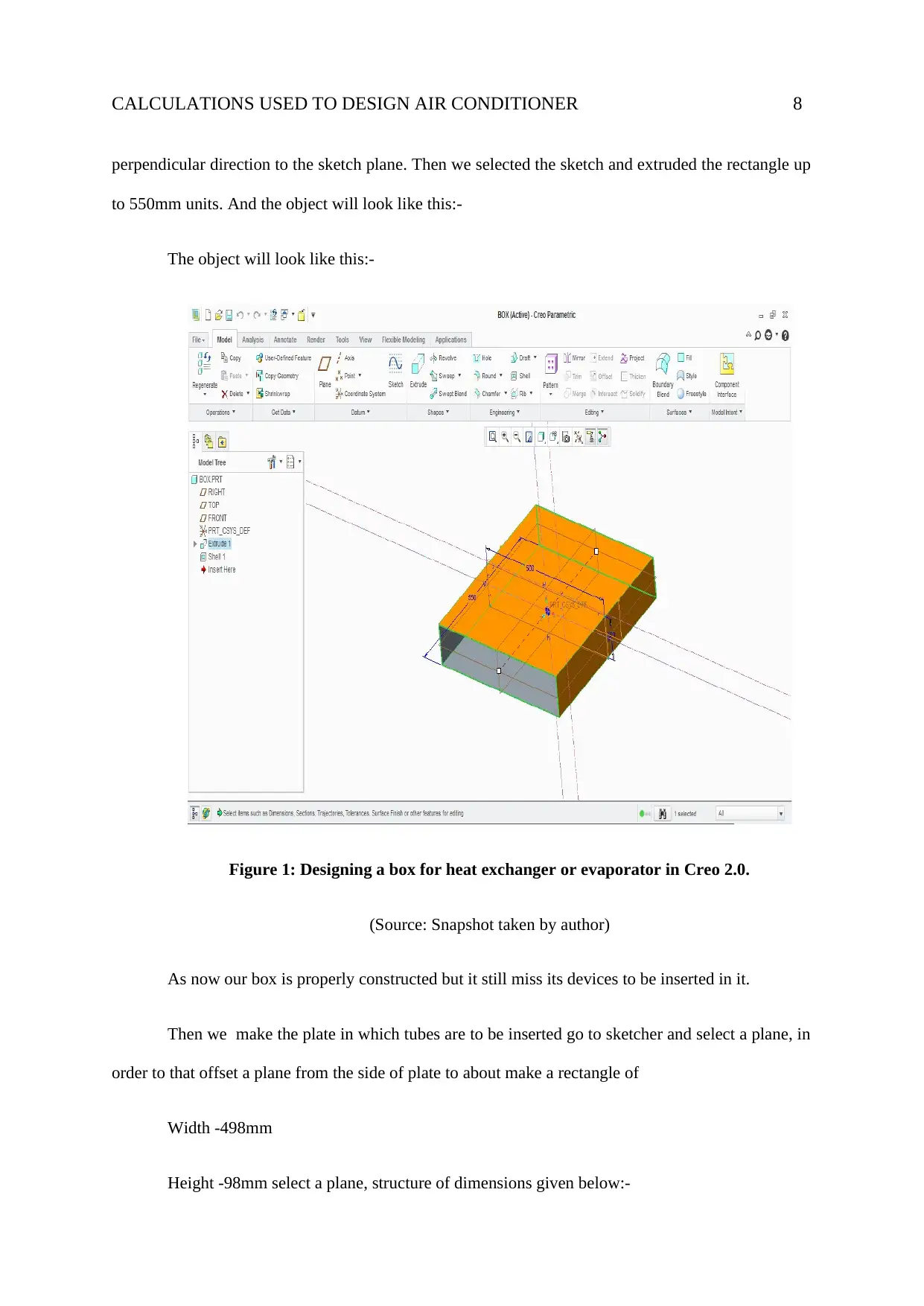
CALCULATIONS USED TO DESIGN AIR CONDITIONER 8
perpendicular direction to the sketch plane. Then we selected the sketch and extruded the rectangle up
to 550mm units. And the object will look like this:-
The object will look like this:-
Figure 1: Designing a box for heat exchanger or evaporator in Creo 2.0.
(Source: Snapshot taken by author)
As now our box is properly constructed but it still miss its devices to be inserted in it.
Then we make the plate in which tubes are to be inserted go to sketcher and select a plane, in
order to that offset a plane from the side of plate to about make a rectangle of
Width -498mm
Height -98mm select a plane, structure of dimensions given below:-
perpendicular direction to the sketch plane. Then we selected the sketch and extruded the rectangle up
to 550mm units. And the object will look like this:-
The object will look like this:-
Figure 1: Designing a box for heat exchanger or evaporator in Creo 2.0.
(Source: Snapshot taken by author)
As now our box is properly constructed but it still miss its devices to be inserted in it.
Then we make the plate in which tubes are to be inserted go to sketcher and select a plane, in
order to that offset a plane from the side of plate to about make a rectangle of
Width -498mm
Height -98mm select a plane, structure of dimensions given below:-
⊘ This is a preview!⊘
Do you want full access?
Subscribe today to unlock all pages.

Trusted by 1+ million students worldwide
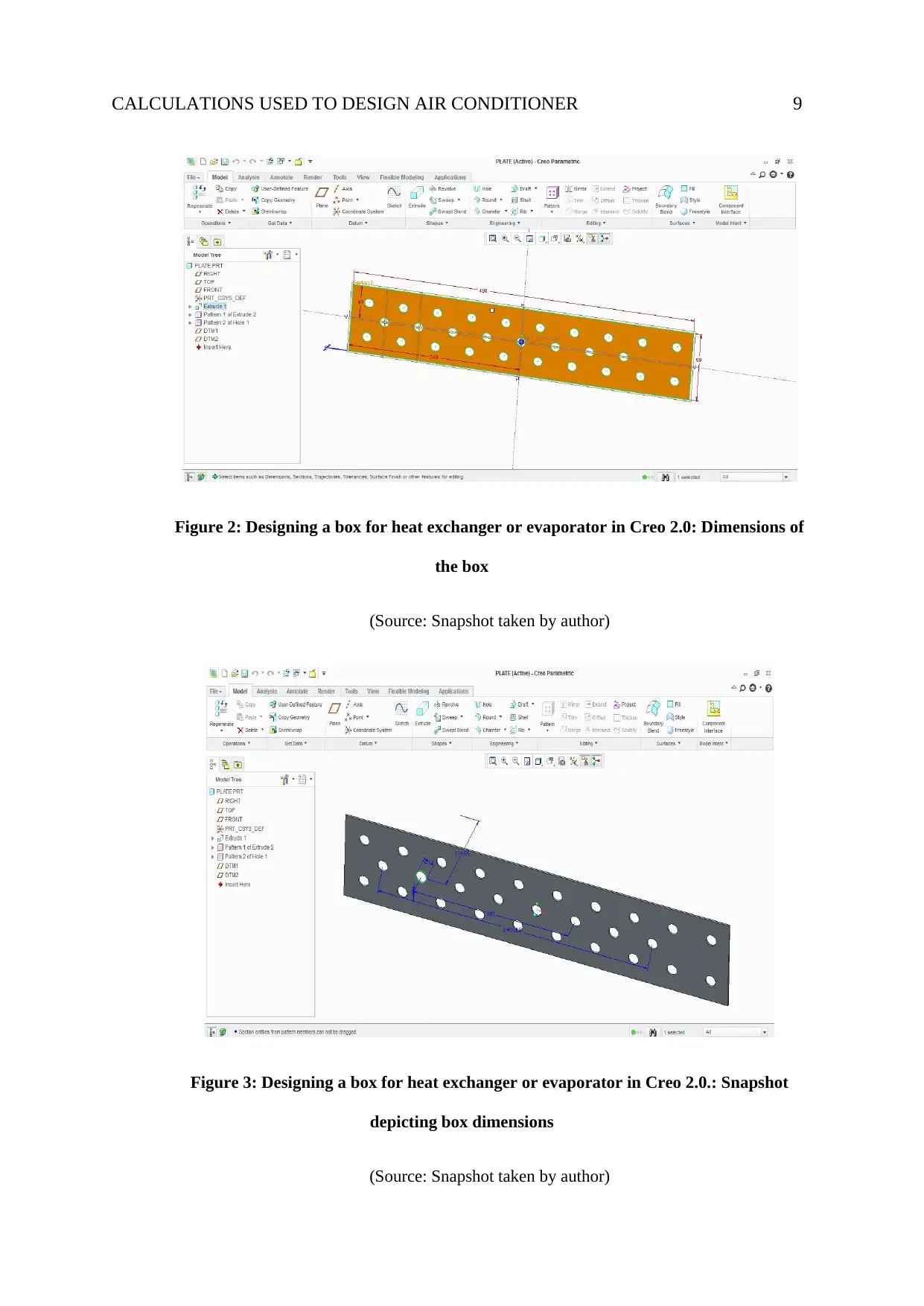
CALCULATIONS USED TO DESIGN AIR CONDITIONER 9
Figure 2: Designing a box for heat exchanger or evaporator in Creo 2.0: Dimensions of
the box
(Source: Snapshot taken by author)
Figure 3: Designing a box for heat exchanger or evaporator in Creo 2.0.: Snapshot
depicting box dimensions
(Source: Snapshot taken by author)
Figure 2: Designing a box for heat exchanger or evaporator in Creo 2.0: Dimensions of
the box
(Source: Snapshot taken by author)
Figure 3: Designing a box for heat exchanger or evaporator in Creo 2.0.: Snapshot
depicting box dimensions
(Source: Snapshot taken by author)
Paraphrase This Document
Need a fresh take? Get an instant paraphrase of this document with our AI Paraphraser
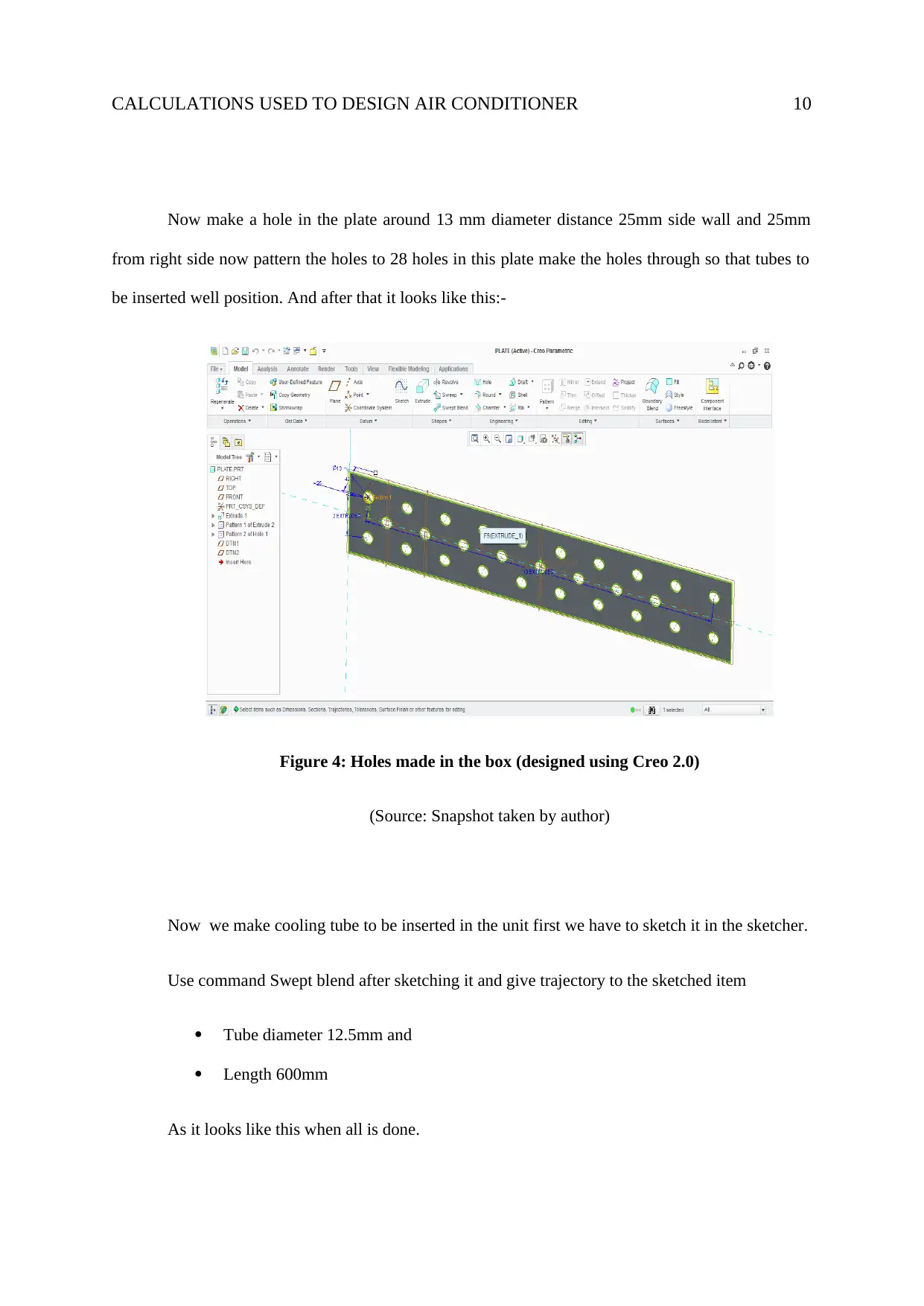
CALCULATIONS USED TO DESIGN AIR CONDITIONER 10
Now make a hole in the plate around 13 mm diameter distance 25mm side wall and 25mm
from right side now pattern the holes to 28 holes in this plate make the holes through so that tubes to
be inserted well position. And after that it looks like this:-
Figure 4: Holes made in the box (designed using Creo 2.0)
(Source: Snapshot taken by author)
Now we make cooling tube to be inserted in the unit first we have to sketch it in the sketcher.
Use command Swept blend after sketching it and give trajectory to the sketched item
Tube diameter 12.5mm and
Length 600mm
As it looks like this when all is done.
Now make a hole in the plate around 13 mm diameter distance 25mm side wall and 25mm
from right side now pattern the holes to 28 holes in this plate make the holes through so that tubes to
be inserted well position. And after that it looks like this:-
Figure 4: Holes made in the box (designed using Creo 2.0)
(Source: Snapshot taken by author)
Now we make cooling tube to be inserted in the unit first we have to sketch it in the sketcher.
Use command Swept blend after sketching it and give trajectory to the sketched item
Tube diameter 12.5mm and
Length 600mm
As it looks like this when all is done.
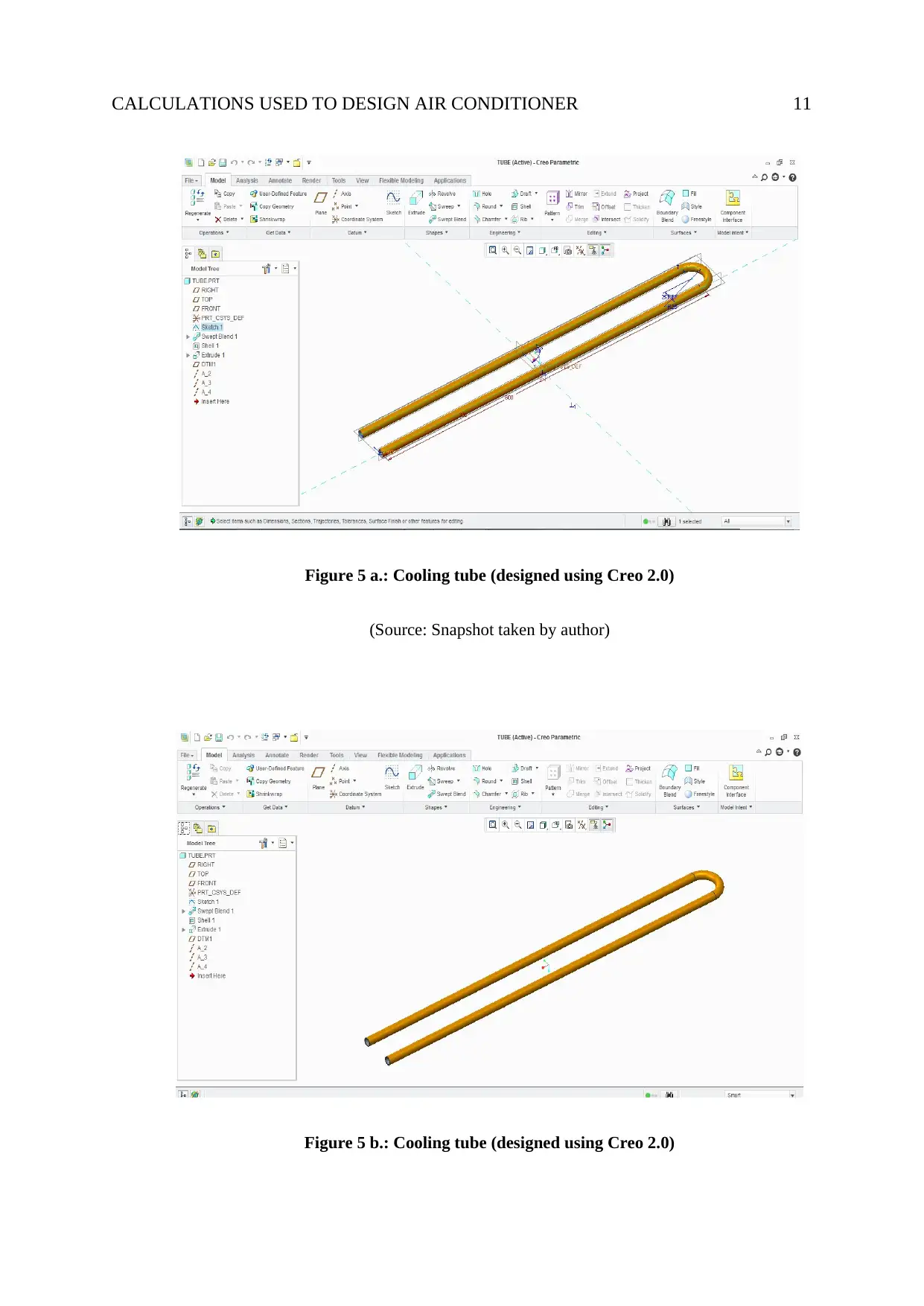
CALCULATIONS USED TO DESIGN AIR CONDITIONER 11
Figure 5 a.: Cooling tube (designed using Creo 2.0)
(Source: Snapshot taken by author)
Figure 5 b.: Cooling tube (designed using Creo 2.0)
Figure 5 a.: Cooling tube (designed using Creo 2.0)
(Source: Snapshot taken by author)
Figure 5 b.: Cooling tube (designed using Creo 2.0)
⊘ This is a preview!⊘
Do you want full access?
Subscribe today to unlock all pages.

Trusted by 1+ million students worldwide
1 out of 17
Your All-in-One AI-Powered Toolkit for Academic Success.
+13062052269
info@desklib.com
Available 24*7 on WhatsApp / Email
![[object Object]](/_next/static/media/star-bottom.7253800d.svg)
Unlock your academic potential
Copyright © 2020–2025 A2Z Services. All Rights Reserved. Developed and managed by ZUCOL.
